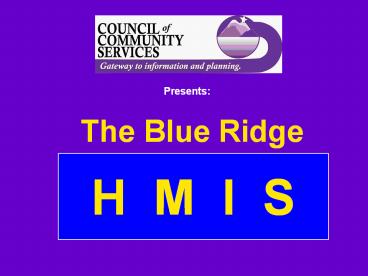HMIS Training - PowerPoint PPT Presentation
1 / 18
Title:
HMIS Training
Description:
Who is homeless? Where do people receive shelter and services and where did they live before ... Homeless Management Information System A Homeless Management ... – PowerPoint PPT presentation
Number of Views:489
Avg rating:3.0/5.0
Title: HMIS Training
1
Presents
The Blue Ridge
H M I S
2
Overview
- What is HMIS?
- Benefits of HMIS
- Pros and Cons of HMIS
- HMIS is a Tool, Not the Goal
3
What is HMIS?Homeless Management Information
System
- A Homeless Management Information System (HMIS)
is a computerized data collection tool
specifically designed to capture client-level,
system-wide information over time on the
characteristics and services needs of men, women,
and children experiencing homelessness. - HMISs are typically web-based software
applications that local homeless communities
implement to enter and share client-level data
across agencies about homeless persons served in
shelters or other homeless service agencies. - HMIS allows the aggregation of client-level data
across homeless service agencies to generate
unduplicated counts and service patterns of
clients served.
4
What is HMIS? continued
- An HMIS is either a vendor developed or a
communitys locally developed software system
that records and stores information on homeless
clients served - HUDs National Data and Technical Standards
establish baseline standards for participation,
data collection, privacy and security - Implementation of HMIS is a requirement for
receipt of Department of Housing and Urban
Development (HUD) McKinney-Vento funding
5
Whats in HMIS?
- HMIS records and stores
- Client Intake
- Demographics
- Basic assessment of needs
- Bed utilization
- Service Tracking
- Services delivered by a provider
- Services received by clients
- Gaps in the homeless services in a community
6
How can HMIS Help us?
- Case Management
- Ability to plan, schedule, and follow-up on
delivery of services - Ability to track changes in clients over time
- Ability to monitor and measure performance goals
and outcomes - Information and Referral (I R)
- Database of available resources
- Online referrals
- Electronic submission of applications for
benefits and eligibility determination
7
Triangle of Benefits of HMIS
8
Benefits for HomelessMen, Women, and Children
- Decrease in duplicate intakes and assessments
- Streamlined referrals
- Coordinated case management
- Mainstream benefit eligibility and/or
determination - Professional development through involvement in
planning process
9
Benefits for HomelessService Providers
- Improve agency effectiveness through tracking
client outcomes - Coordinate services, internally among agency
programs, and externally with other providers - Prepare financial and programmatic reports for
funders, boards, and other stakeholders - Inform program design decisions
10
Benefits for Community Coordinators,Policy
Makers, and Government Officials
- Increase understanding of the local extent and
scope of homelessness - Facilitate an unduplicated count of persons
experiencing homelessness - Identify service gaps (i.e. are the services
available meeting the needs of clients) - Inform systems design and policy decisions
- Develop a forum for addressing community-wide
issues
11
Pros and Cons of HMIS vs. Traditional Methods
Why is HMIS a better alternative thanpoint in
time counts or aggregate service provider reports
forgathering community-wide information on
homelessness?
- Method Point in Time Counts
- Count everyone who is homeless on one night
- Pro Unduplicated number of people on the street
or in shelter in one night, includes those not
served by homeless programs - Con No information on whether those people were
homeless for one night or all year.
Under-represents those that move in and out of
the system throughout a time period
12
Pros and Cons of HMIS vs. Traditional Methods
Why is HMIS a better alternative thanpoint in
time counts or aggregate service provider reports
forgathering community-wide information on
homelessness?
- Method Summation of aggregate reports from
funded agencies - Each program generates aggregate data about
persons served over a time period (i.e. a year) - Pro Broader information about population served
throughout all programs - Con Duplicated counts, the same people are
counted by multiple programs limited
understanding of patterns of service use or total
population size.
13
Why HMIS Over Other Methods?
- Summary of Approaches
14
HMIS is a Tool, Not the Goal
- What questions can HMIS help to answer
- At the local level?
- At the national level?
15
What Questions Can HMIS Answer for Local
Communities?
- How many people are homeless on the streets and
in the service system? - How many are chronically or episodically
homeless? - What are the characteristics and service needs of
those served? - Which programs are most effective at reducing and
ending homelessness?
16
What Questions Can HMIS Answer for the Nation?
- How many people are homelessin the United
States? - Who is homeless?
- Where do people receive shelter and services and
where did they live before homelessness? - What are the patterns of homeless residential
program use? - What is the nations capacity for housing
homeless people and how much is utilized?
17
Summary of Key Issues
- HMIS Benefits all stakeholders
- Homeless Individuals Families
- Service Providers
- CoC, Policy Makers, and Government
- HMIS does more than just collect data
18
H M I S
- Contact the HMIS Coordinator for any questions
you may have about the Blue Ridge HMIS. - You can reach the HMIS Coordinator at
- leeb_at_councilofcommunityservices.org,
- Or (540) 985-0131, x703































